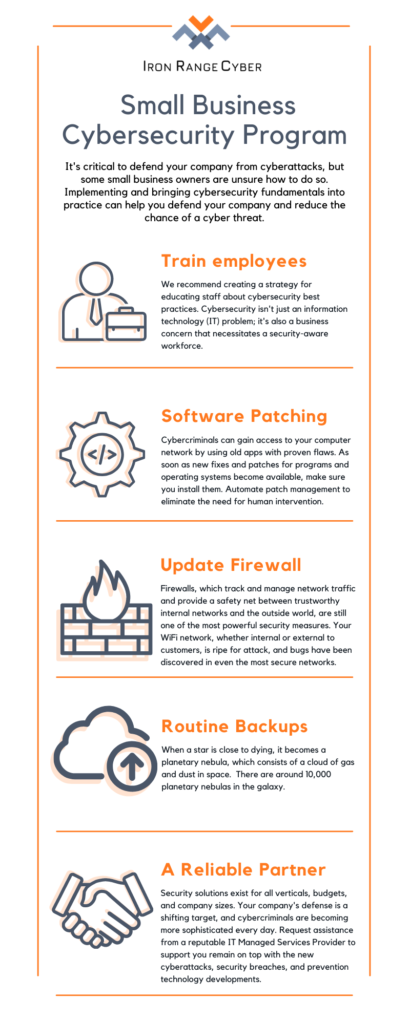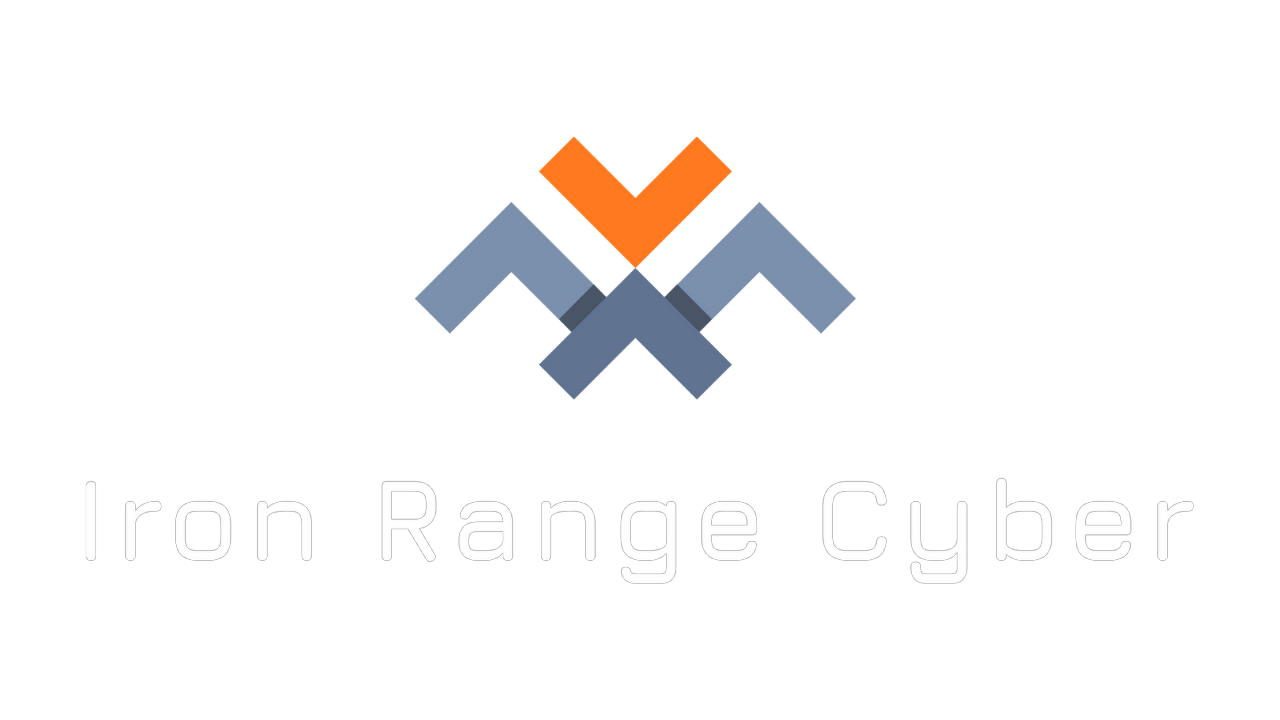How to Build a Small Business Cybersecurity Program
Cybercriminals prey on companies of all sizes and all verticals. According to a survey conducted by the Better Business Bureau, cyberattacks have affected 22% of small businesses. These cybercriminals use phishing attacks, malware, ransomware, and other scams to gain access to sensitive data. Small business owners have fewer resources to create and maintain secure networks, making it easier to fall prey to a data breach. While bigger organizations store far more information to steal, small businesses have less secure networks, making it easier to breach the network resulting in data loss.
It’s critical to defend your company from cyberattacks, but small business owners are often unsure how to do so. Implementing cybersecurity best practices including internet security, mobile security, and incident response capabilities into practice can help you defend your company and reduce the risk of a cyberattack.
This Iron Range Cyber guide for cybersecurity tips will help you measure the efficacy of your latest cybersecurity activities and maneuver through the world of cyber threats.
- Train employees so they understand the cybersecurity policy.
Creating compliance procedures and standards for users accounts an essential part of any cybersecurity plan. This involves requiring secure passwords and developing appropriate Internet access rules that go into the company’s basic security policy in depth. We recommend creating a strategy for educating staff about cybersecurity best practices. Cybersecurity isn’t just an information technology (IT) problem; it’s also a business concern that necessitates a security-aware workforce. At the end of the day, the end-users who handle confidential data are responsible for its protection. They can unknowingly put you at risk if they don’t realize or appreciate their responsibility to protect confidential data and communicate safely with a company computer system. To secure your networks and files, your staff should be qualified to detect and report phishing attacks and other forms of cybercrime, social engineering attacks, and cyber risk.
- Keep all software application patches up to date.
Cybercriminals can gain access to your computer network by using old apps with vulnerabilities As soon as new fixes and patches for programs and operating systems become available, make sure you install them. The WannaCry and Petya ransomware attacks, which made headlines a few years back, took advantage of Microsoft‘s Windows Server Message Block (SMB) protocol. The outbreak may have been avoided with a quick fix, highlighting the effectiveness of patch control in preventing cyber attacks. We recommend implementing stringent patching rules to ensure that employees won’t ignore program update prompts, or better yet, automate patch management to eliminate the need for human intervention.
- Install and update your firewall.
A powerful firewall is one of the first lines of security in a cyberattack. Firewalls, which track and manage network traffic and provide a safety net between trustworthy internal networks and the outside world, are still one of the most powerful security measures. Your WiFi network, whether internal or external to customers, is ripe for attack, and bugs have been discovered in even the most secure networks. Take a holistic approach to enhance the reliability of your firewall, endpoints, and WiFi network.
- Make routine backups of all your files.
Often back up all of your company records, including cloud-based data. Check the on-premise and cloud servers for proper operation on a daily basis to ensure you have the most recent backup. Make a list of all the different kinds of data and classified information you have on hand. Any corporation has confidential data it stores, manages, and transmits to conduct business, whether it’s consumer payment details, patient health reports, personal financial details, or intellectual property. It is your responsibility as a company to safeguard it.
- Install anti-malware software on your devices.
Anyone can be a victim of a data breach, no matter how vigilant your business is. Since phishing attacks focus on infecting an employee’s machine with ransomware, it’s critical to have anti-malware and antivirus software enabled on all computers and across the network. Implementing these software tools is an important step in risk management.
- Create a mobile device cybersecurity plan.
Mobile devices may also pose a cybersecurity risk, particularly if they hold sensitive business information. All employees should be required to use strong passwords to secure their computers, phones, tablets, and other devices. Install security software, and encrypt their sensitive information to help prevent a costly data breach. Establish procedures for disclosing missing or stolen business property as well.
- Put in place strict data IT security protocols.
The best protection against cybersecurity threats is to keep your office computers updated with the new applications, web browsers, and operating systems. Create and implement a corporate data management approach that includes robust compliance controls focused on access control. Make a list of all the hardware and software devices that are connected to your network. As straightforward as it might be, this is a place where businesses are more affected, as shown by last year’s notorious Equifax hack. You ought to know which systems in your environment need to be upgraded or patched as important bugs are announced. Creating and managing a list of hardware and software devices is important for implementing a strong cybersecurity program.
- Make sure employees use strong passwords.
Good passwords are a complicated mix of special characters, numbers, and letters that increase the security of all your accounts. When accessing confidential business details, require all workers to use two-factor authentication. Be sure they know to never share passwords, access credentials, or customer information with anyone, even other employees.
- Limit who has permission to push software updates to apps.
Both data infrastructure and software installations can be restricted to a small number of employees. Any implementation should only serve the needs of their job and be done with the network administrator’s approval. Determine which employees in the organization need access to which categories of data and implement an access management policy to control this. Maintain the security of everyone’s passwords in your organization, in addition to access management policies. Password security should be implemented, and staff should be educated about the importance of using strong passwords.
- For remote network security, use multi-factor authentication.
Employees of many businesses provide online access to business infrastructure. In most instances, only a password protects access to confidential programs and records. User-selected passwords are usually easy to guess or can be accessed with a simple e-mail phishing attack. If all remote access does not require multi-factor authentication, an intruder who obtains a password would have no problem accessing remote services, which also leads to access to confidential data.
- Find a reliable partner who will assist you.
Two significant problems companies face when it comes to successful cybersecurity are a lack of time and staffing. Having a third party do penetration testing or risk assessments for your company is critical for obtaining reliable validation that your cybersecurity strategy is working and that your confidential data is as safe as possible. Security solutions exist for all verticals, budgets, and company sizes. If your business has an internet connection, you need a cybersecurity expert on your side.
Cybersecurity Resources for Small Businesses
NIST Small Business Cybersecurity Corner
FTC Cybersecurity for Small Business
U.S. Department of Homeland Security Cyber Security Resources




